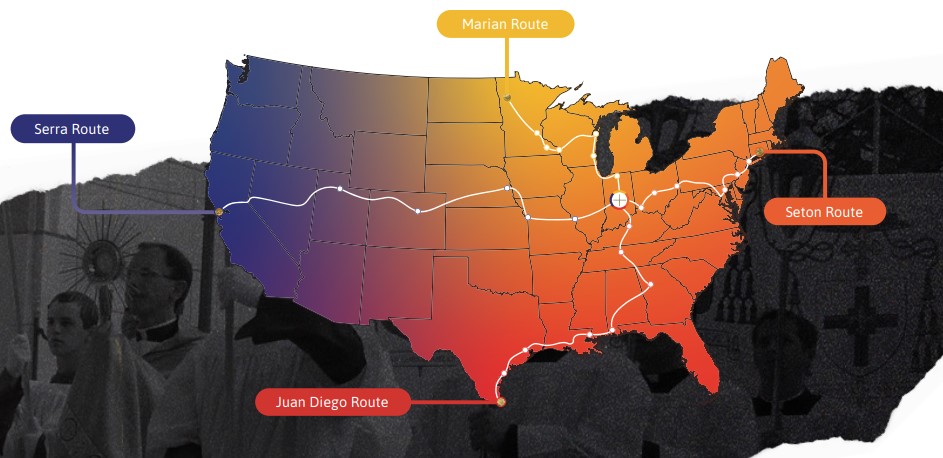
A National Eucharistic Pilgrimage will spend 14 days traveling through Wisconsin next year — including about six days in the Archdiocese of Milwaukee.
The northern Marian Route is one of four routes to begin in different regions of the United States and converge in Indianapolis on July 16, 2024, for the 10th National Eucharistic Congress. Organizers hope to draw 80,000 Catholics to the event, which will be held at Lucas Oil Stadium.
While 12 “perpetual pilgrims” and a priest chaplain will travel the entire Marian route, parishes along the route will host Mass, Adoration, 40 Hours devotions, praise and worship services, lectures on the Eucharist, pilgrim testimonies, meals and fellowship. This will be the case for each of the four routes.
“It is a stirring vision — Christ truly present in the Eucharist, traveling across our nation inviting crowds of hungry souls to come and be fed,” said Will Peterson, head of Modern Catholic Pilgrim, which is coordinating the effort. “The pilgrimage is modeled after the road to Emmaus, and is an invitation for pilgrims to encounter the risen Christ on the journey and in the breaking of the bread before being missioned back into their local communities to spread the fire.”
In the Gospel of Luke, two disciples walking to Emmaus three days after the Crucifixion encounter a stranger who they recognize as Jesus only after he breaks bread with them.
The National Eucharistic Pilgrimage will kick off May 17-19, 2024, during the feast of Pentecost.
Spanning a combined distance of 6,500 miles through cities and along highways, mountain ranges and rural towns, each pilgrimage route will be accompanied by a consistent group of “perpetual pilgrims,” a priest chaplain, and a support vehicle for legs of the journey in which safety, terrain and/or climate may present obstacles. The support vehicle will also allow pilgrims to get to their destinations according to schedule for areas in which the distance is too great to travel on foot.
The northern Marian route is named for its planned visit to the National Shrine of Our Lady of Champion — formerly Our Lady of Good Help — the only approved Marian apparition site in the United States. The shrine is located about 16 miles northeast of downtown Green Bay.
A general schedule for each route of the national pilgrimage route will consist of Mass and a major solemn procession on Sundays, with Mass and smaller processions at parishes during the week. Pilgrims will travel 10-15 miles each day while taking part in a minor Eucharistic procession.
The general public may walk along with the pilgrims for any length of time they wish — from a few minutes to several days — but must arrange for their own transportation and lodging.
Marian Route pilgrims will begin in Bemidji/Lake Itasca, Minnesota, and travel south to be in La Crosse June 7-9.
From La Crosse, the pilgrimage will cross Wisconsin to visit Green Bay from June 14-16 and the National Shrine of Our Lady of Champion northeast of Green Bay, and then travel south to be in Milwaukee from June 21-23.
From Milwaukee, the pilgrimage will travel to archdiocese communities to the south and then spend time in Chicago from June 28-30. It will then move on to Notre Dame, Indiana, before it reaches Indianapolis on July 16 prior to the National Eucharistic Congress.
Archbishop Jerome Listecki is delighted that the Marian Route procession will spend about six days in rural and urban parts of the 10-county Archdiocese of Milwaukee.
“The Eucharist is the source and summit of our faith. This national pilgrimage will provide unique opportunities for Catholics here to fall deeper in love with Jesus in the Eucharist and to be inspired to share that love with others,” Archbishop Listecki said.
The pilgrimage is part of the National Eucharistic Revival, a massive, three-year initiative that began one year ago on the feast of Corpus Christi, June 19, 2022.
“The National Eucharistic Revival is a movement to restore understanding and devotion to this great mystery here in the United States by helping us renew our worship of Jesus Christ in the Eucharist,” the National Eucharistic Revival website notes.
Why now?
“The difficulties and challenges over the last few years have shed light on the Church’s need for healing, unity, formation and conversion. More than 30 percent of Catholics have not returned to the pews post-pandemic, and recent data reveals that the majority of Mass-going Catholics do not believe in the Real Presence of Christ in the Eucharist. The past decade has also seen the rise of the ‘nones’ among the millennial generation, with more than 40 percent now self-identifying as ‘unaffiliated’ with any religion. Many young Catholics find the faith to be irrelevant to the meaning of their lives and challenges,” the website states.
To discern involvement in the National Eucharistic Pilgrimage, all Catholics are encouraged to visit www.eucharisticpilgrimage.org to view a map of the routes and a schedule of cities each pilgrimage travels through, find answers to frequently asked questions, learn about the patron saint for each route and sign up to receive updates about specific routes.
Other routes of the National Eucharistic Pilgrimage that will meet in Indianapolis include the Seton Route that will begin in Connecticut; the Juan Diego Route that will begin in Texas and the Serra Route that will begin in California.
Marian Route of Pilgrimage Spends Time in Wisconsin
The northern route of the National Eucharistic Pilgrimage in 2024 will visit several local cities on weekends and pass through other communities on weekdays:
- LA CROSSE – June 7–9, 2024
- GREEN BAY – June 14–16, 2024
- MILWAUKEE – June 21–23, 2024
- CHICAGO – June 28–30, 2024
